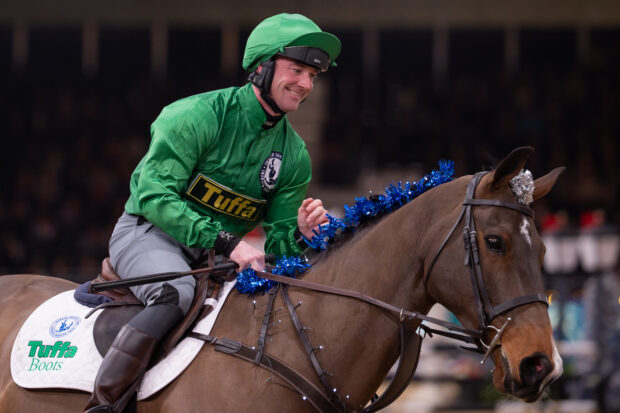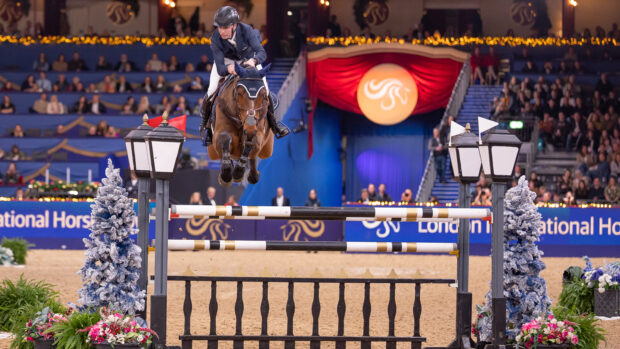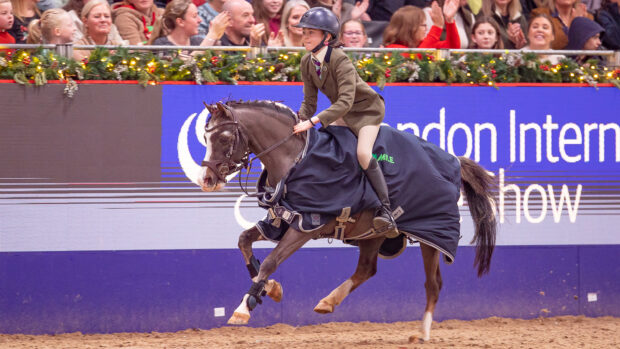Gareth Hughes and Richard Davison hosted the “Dressage Unwrapped” masterclass at the London International Horse Show 2023, sharing exercises and tips on how to introduce the more advanced dressage movements into your horse’s training.
They were joined in the New Horizon Plastics London Arena by their demo riders: Gareth’s daughter and grand prix rider, 16-year-old Ruby Hughes and Classic Flamboyant, as well as Yasmin Ingham aboard her eventing World Championships-winning ride Banzai Du Loir.
1. Advanced dressage training tips: how to introduce flying changes
Before working on the flying changes both Gareth and Richard spent time working on the quality of the canter with their riders. The changes are all about the canter and your ability to adjust and balance it, Gareth explained.
Richard had Yasmin work on counting her canter strides between markers and then changing the canter, adding or removing a stride.
“You don’t need an arena to do this, when you’re out hacking just pick two markers, like a fencepost, and do the same thing,” Richard said.
When introducing single flying changes he had Yasmin ride a serpentine down the arena, changing over the centre line. To start with, Banzai was quite reactive to the leg, so the two were working on making her aids as subtle as possible.
“If a horse reacts and makes a mistake in change, don’t punish him,” said Gareth. “They’ve offered a reaction and that’s what we want.”
With a reactive horse like Banzai, Richard described how he wouldn’t ride a change on every loop of the serpentine. Instead, on some loops, he would keep counter canter.
“This prevents horses from anticipating the change and helps to keep them on your aids,” he said.
2. How to work on the zig-zag and count your tempis
Once the canter was established, Gareth took Ruby through an exercise that lays the foundation for the canter zig-zag in the grand prix.
On the long sides of the arena, he had Ruby ride a half-pass for four strides, ride straight for four strides, change, then straight into four half-pass strides back to the track, change, and finishing on another four straight strides before the corner.
That can seem like a lot of counting, but Gareth explained how important it is to be disciplined with counting your strides at this point – and getting it right – because the grand prix zig-zag is such a demanding movement that requires precision.
If it helps, you can have someone on the ground count your strides for you, as Gareth was doing for Ruby.
That same applies for tempi changes, for which Gareth had another tip.
“If we’re riding three-time changes, I won’t count ‘one, two, three; one, two, three,’ – instead I’d count ‘one, two, three; two, two, three; three, two, three,’ and so on,” he said.
The first number always indicates how many changes the rider has made. With precision again in mind, Gareth wants his riders to get into the habit early of riding a set number of changes, even in training.
3. Ride the shoulder-in forwards
Richard explained how the trot and canter should be adjustable during lateral work. He had Yasmin ride transitions within the pace in both shoulder-in and travers – at times extending the stride and at other times bringing it back.
“From the side, you shouldn’t be able to tell the horse is in shoulder-in or travers, the quality of the trot should look the same,” he said.
When people start to introduce lateral work they tend to bring the horses back too much. In contrast, Richard had Yasmin riding some medium trot strides in shoulder-in, which you wouldn’t find in an eventing dressage test, but riding these movements in training teaches the horse to maintain the impulsion when lateral work is introduced.
4. “Change one thing at a time”
When working on the canter pirouette, Gareth started by asking Ruby to ride travers along the long side, making sure to keep the impulsion in the canter, before bringing the same exercise onto a circle around him. Ruby started by bringing the circle smaller, until it was around eight metres, still in travers. Gareth then asked her to gradually collect until the canter resembled a pirouette-canter.
“Training the pirouettes is like us going into the gym and squatting, it’s very demanding of the horse and you can’t ride it every day,” Gareth said.
To exit the travers on the eight-metre circle, Gareth first asked Ruby to ride straight, and then forward. This sequential pattern – riding straight and then forward – changing one thing at a time, is important because horses remember patterns explained Gareth.
“If Ruby had asked for both straightness and forwardness at the same time, the next time she asked the horse to go straight, she would also go forward,” he said.
The same rule applies to training sessions more broadly, with Gareth describing how he won’t just take his advanced horses through all the higher-level movements in a single session.
Rather, he might work on changes one day and then piaffe-passage the next before giving the horse a rest or taking them hacking.
He will also return to the advanced dressage training tips and exercises he shared here to focus on perfecting the foundations.
You may also be interested in…

‘Social media makes things look easy’: Gareth Hughes reflects on dreams, horsemanship and advice for younger riders

‘It makes me emotional to think what I’ve achieved this year’: Charlotte Dujardin wows en route to London International freestyle victory

‘Keep it fun and easy’: Charlotte Dujardin’s top 5 tips for developing young horses

Subscribe to Horse & Hound magazine today – and enjoy unlimited website access all year round
Horse & Hound magazine, out every Thursday, is packed with all the latest news and reports, as well as interviews, specials, nostalgia, vet and training advice. Find how you can enjoy the magazine delivered to your door every week, plus options to upgrade your subscription to access our online service that brings you breaking news and reports as well as other benefits.






